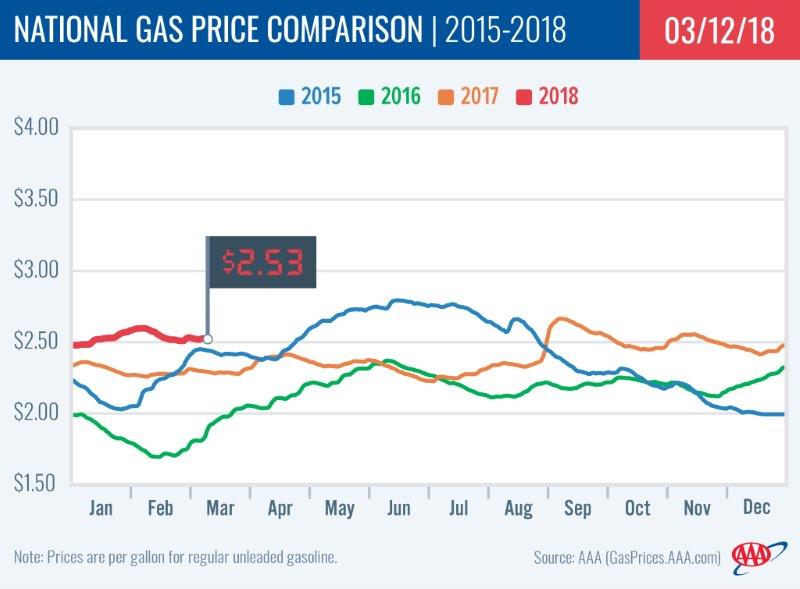PORTLAND, Ore., – The national average is flat and has remained fairly steady for the past 10 days while prices in the West Coast, Great Lakes and Central states are inching up. For the week, the national average for regular remains at $2.52 a gallon while the Oregon average ticks up one-and-a-half cents to $2.92, which is a new year-to-date high for the Oregon average. The national average peaked for the year so far at $2.61 on Feb. 5.
“The national average is stable due to increased U.S. gasoline production that has kept pace with higher than usual demand this winter. The latest report from the U.S. Energy Information Administration (EIA) shows that demand increased week-over-week, registering at 9.2 million b/d, the highest gasoline demand level seen this year,” says Marie Dodds, public affairs director for AAA Oregon/Idaho.
AAA continues to predict that gas prices will rise to their spring highs between around April 1 and June 21. Spring prices will be higher than the last couple of years, but likely not as expensive as in 2014 when the national average peaked at $3.70 and the Oregon average peaked at $3.99.
Oregon is one of 13 states and the District of Columbia where gas prices are higher week-over-week. The largest increase is in Michigan (+6 cents). The largest decrease is in Florida (-4 cents).
Oregon is one of 10 states where prices are higher now than a month ago. The national average is five cents less and the Oregon average is four cents more than a month ago. The largest monthly increase is in Hawaii (+6 cents). The largest monthly decrease is in Florida (-14 cents).
The West Coast still has the most expensive gas prices in the nation with six of the top ten states in this region. Hawaii tops the list, followed by California, Alaska and Washington. These states are the only four with averages at or above $3 a gallon. Oregon is fifth most expensive for the sixth week in a row.
| Rank | Region | Price on 3/13/18 |
| 1 | Hawaii | $3.51 |
| 2 | California | $3.38 |
| 3 | Alaska | $3.06 |
| 4 | Washington | $3.02 |
| 5 | Oregon | $2.92 |
| 6 | Nevada | $2.81 |
| 7 | Pennsylvania | $2.76 |
| 8 | District of Columbia | $2.75 |
| 9 | New York | $2.69 |
| 10 | Connecticut | $2.68 |
According to the EIA, West Coast gasoline inventories saw a 1.2 million bbl build last week – the largest increase in nearly two months. Total gasoline stocks in the region sit at 34.4 million bbl, which is approximately 4 million bbl more than the level at this time last year.
The nation’s cheapest markets are Alabama ($2.26) and South Carolina ($2.26). For the 32nd week in a row, no states have an average below $2.
Drivers in 49 states and the District of Columbia are paying are paying more than a year ago to fill up. The national average is 23 cents more and the Oregon average is 24 cents more than a year ago. This is the 19th-largest yearly increase in the country. Hawaii has the greatest year-over-year increase of 43 cents; California is second at 38 cents. The only state to see its average price decrease compared to one year ago is Utah (-1/2 cent).
Oil Market Dynamics
Crude oil prices took a hit early last week, then rebounded before the weekend. Crude prices slipped after the EIA’s weekly report showed that crude oil inventories increased by 2.4 million bbl last week. Then prices rebounded due to a strong rally of the stock market. The price of crude has the potential to slide this week amid the fact that U.S. crude production continues to boom.
Crude production hit another record at 10.37 million b/d last week. Market observers are likely to continue watching this number to see if it begins to outpace domestic and global crude oil demand. According to Baker Hughes, the U.S. lost four active oil rigs last week. The current total stands at 796, which is 179 more than last year’s count at this time.
At the close of Friday’s formal trading session on the NYMEX, WTI increased $1.92 to settle at $62.04. At the close of Monday’s formal trading session on the NYMEX, WTI lost $0.68 to settle at $61.36. Today crude is trading around $61, compared to $62 a week ago. Crude prices are up about two percent in the last month and are about $13 more per barrel than a year ago.
Drivers can find current gas prices along their route with the free AAA Mobile app for iPhone, iPad and Android. The app can also be used to map a route, find discounts, book a hotel and access AAA roadside assistance. Learn more at AAA.com/mobile.
Diesel
For the week, the national average slips two cents to $2.93 a gallon. Oregon’s average holds steady at $3.07. A year ago the national average for diesel was $2.52 and the Oregon average was $2.69.
Find current fuel prices at GasPrices.AAA.com.
AAA news releases, high resolution images, broadcast-quality video, fact sheets and podcasts are available on the AAA NewsRoom at NewsRoom.AAA.com.



